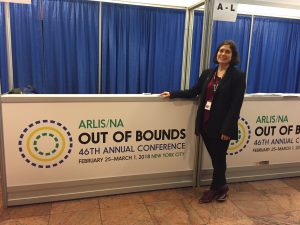Copyright Assessment in the Trenches: Workflow, Tools, Metadata, and more is the title to a session panel I recently took part in at the Art Libraries Society of North America (ARLIS/NA) Out of Bounds 46th Annual Conference, 2018 in New York, NY. Every year members from museums, galleries, academic, and special libraries get together to discuss libraries in an art context. I jumped at the invitation to co-present when I learned the panel would consist of two copyright lawyers in libraries and two non-lawyer librarians who make copyright determinations as part of their job. As a former art librarian, I’ve maintained relationships with colleagues in the field and have presented on copyright, so it was a natural fit. The four panelists included:
Greg Cram, Associate Director of Copyright and Information Policy at The New York Public Library
Rina Elster Pantalony, Director of Copyright Advisory Services, Columbia University
Megan De Armond, Assistant Digital and Metadata Librarian, Frick Art Reference Library
Victoria Pilato, Digital Projects Librarian, Stony Brook University
Our panel moderator:
Deborah Kempe, Chief Collections Management & Access, Frick Art Reference Library
This session blossomed from a recommendation at the 2017 ARLIS/NA conference that there should be a copyright panel at every library conference. This makes a lot sense when you think about it because many librarians make decisions regarding copyright at some point and do not have formal training or the support of a legal team. Our panel was special because it included two copyright lawyers in libraries (public and academic) that could speak to the law and what it means for librarians, as well as able to update the audience on current projects and initiatives to make the lives of librarians easier when making copyright determinations. And, ultimately, how to make materials accessible to a wider audience. The other two panelists, including myself, were the non-lawyer librarians who deal with copyright issues a lot in our jobs as digital projects librarians. We honestly discussed how we handle copyright from the materials we encounter, how we assess copyright, and the metadata we create, to the risks we take when addressing copyright.
One significant topic we discussed is the importance of rights metadata for the end user. In other words, how can the person/institution making an item publicly accessible online make it known to the user how they may reuse that item, and how they are able to access it in the first place. Current standards when building digital collections at Stony Brook University Libraries are to use outward facing rights statements (rightsstatements.org), which alert the user to the level of copyright an item holds and clues to how the item may be reused. Information about how that copyright determination is made by the institution is usually inward facing. Possible upcoming best practices I would like to implement, after hearing from Greg and Rina discuss this issue, makes this information outward facing, which could be more beneficial to the end user.
One important tool we discussed during the panel that those of us who make copyright determinations should keep an eye out for in the next few months comes from the New York Public Library. Soon there will be a free and easy way to search the Catalog of Copyright Entries (CCE) for renewals. No more trips to D.C. (has anyone ever done this?). The panelists spoke about tools used when assessing copyright as well. These can be found in the resource list below.
The panel also discussed U.S. Copyright law including Sections 102 and 108(h). The conference ran during Fair Use Week, but as our moderator and panelists made a point to acknowledge during our presentation, every week is fair use week for librarians.
Moving forward, the panelists will collaborate on an article detailing the topics of our presentation. It will include more information about U.S. Copyright law Section 102 and 108(h) than I stated here, but will be sure to speak to the non-lawyer audience.
Copyright Resources List: http://bit.ly/2ETM8Az
ARLIS/NA website: https://www.arlisna.org/

Left to right: Me (Victoria Pilato), Greg Cram, Rina Elster Pantalony, Megan De Armond, Deborah Kempe. Photo by Giana Ricci

After the presentation. Love the conference logo this year. Photo by Sumitra Duncan
Victoria Pilato
Latest posts by Victoria Pilato (see all)
- AI Transparency – How the SBU Libraries Use Artificial Intelligence - December 5, 2025
- Racial Unrest of 2020: Experiences from the Stony Brook University Community - February 9, 2024
- Help us Shape the Future of SBU Libraries: Strategic Planning Community Survey - October 17, 2023

